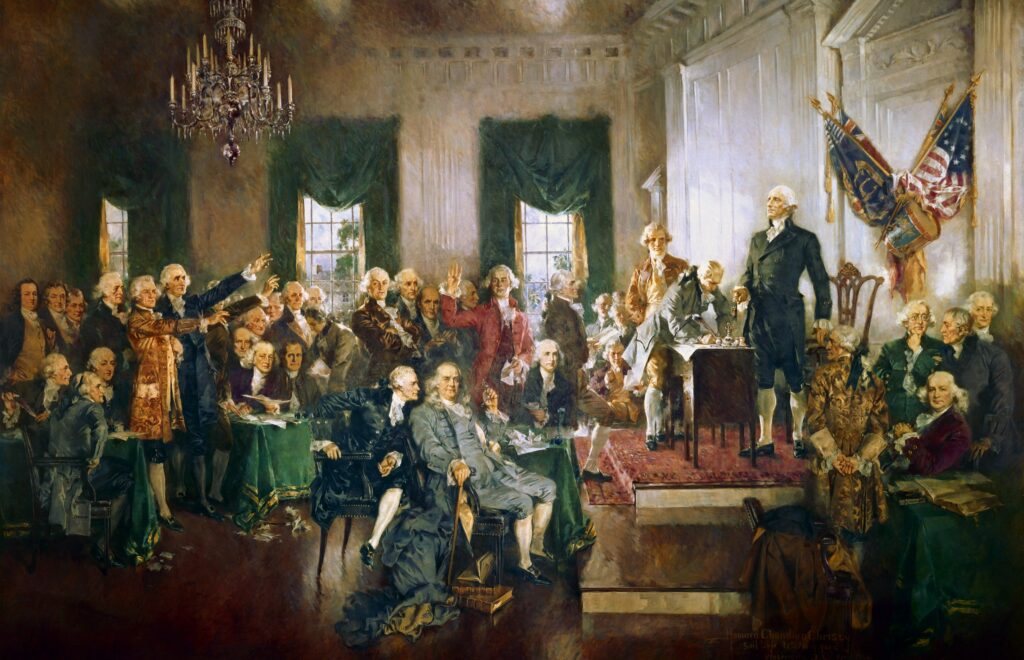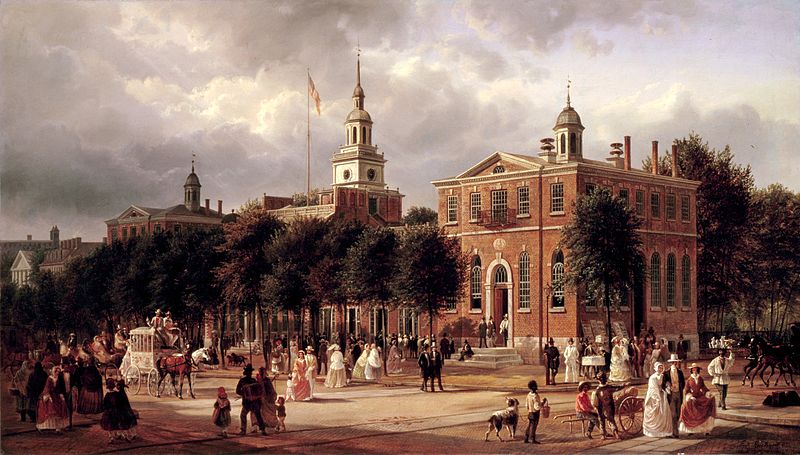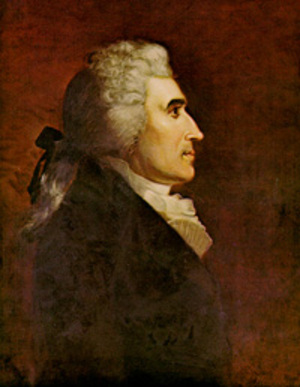
Constitutional Convention

Making Ethical Judgements
Was the Constitutional Convention Legal?

Benjamin Rush declared that the Revolution was not complete until America’s institutions were transformed in accordance with the premises of liberty. The Revolution was not completed until the framers had drafted the Constitution.
The Articles of Confederation required that Congress propose any amendments and that these changes be adopted unanimously.
In September 1786, twelve delegates from five states met in Annapolis, Maryland and issued a call for a second convention to be held in Philadelphia in May 1787, to consider changes that “may be necessary to their common interest and their permanent harmony.”
Madison and his allies persuaded Congress, after months of inaction, to endorse the Constitutional Convention, though the members imposed severe restrictions on the convention’s mandate. On February 21, 1787, the Confederation Congress passed a resolution calling for a convention to discuss “revisions” and “alterations” of the Union.
Madison also convinced Edmund Randolph, the governor of Virginia, to correspond with other governors and legislatures to persuade them to attend the convention. At the head of the list of delegates from Virginia, Madison and Randolph placed the name of George Washington, without consulting the general.
On the question of the legality of the Convention, Washington would say this: “The legality of this Convention I do not mean to discuss….That powers are wanting, none can deny….That which takes the shortest course to obtain them, will, in my opinion, under present circumstances, be found best. Otherwise, like a house on fire, whilst the most regular mode of extinguishing it is contended for, the building is reduced to ashes.”

History Happened Here
Philadelphia in 1787

The Constitutional Convention took place in the nation’s largest and most diverse city. Philadelphia in 1787 had about 40,000 inhabitants. On its streets could be found wealthy Quaker merchants, German-speaking farmers, African-American slaves, and Delaware Indians. Piles of rotten garbage and abandoned animal carcasses also lay in the streets.
Five percent of Philadelphia’s citizens owned half its taxable wealth. The city government was a closed corporation whose members chose their own replacements. Meanwhile, more than half of Philadelphia’s population existed on the edge of poverty. Prostitution and disease were widespread. Many streets were open sewers. Servants spent their evenings in the taverns of a rough waterfront district called Helltown.
Across Walnut Street from Independence Hall (then called the Pennsylvania State House), was a four-story prison. Prisoners called out for alms and cursed passers-by who failed to oblige.
The Convention
The convention was scheduled to begin on May 14th, but did not achieve a quorum of delegations from more than half the states until May 25. Eventually there were 12 delegations. Rhode Island boycotted the convention.
On May 25, 1787, delegates from seven states had arrived. A quorum had been achieved and the convention could begin.
The delegates, fifty-five in all, but never more than thirty or thirty-five at once, sealed themselves inside a room no bigger than a large schoolroom in Philadelphia’s state house. They posted sentries at the doors and windows to keep their “secrets from flying out.” They barred the press and public, and took a vow not to reveal to anyone the words spoken. With the doors and windows closed, the little room where the convention met for up to six hours a day, was stiflingly hot. There were speeches that lasted two, three, or four hours. The convention took a single break, for 11 days.
Over four months, the delegates hammered out compromises that established a system flexible to withstand more than two centuries of change. The delegates’ goals were contradictory: to strengthen the national government and to limit its power.
On many issues, there was deep division. The convention flip-flopped five times on whether the president should be eligible for reelection. When truly stymied, the convention would appoint a committee to come up with a solution and present it to the full convention.
In the end, the Constitution, unlike the Articles of Confederation, gave Congress the power to levy taxes and sole to regulate interstate and foreign trade, a president with the power to veto legislation, while leaving many other responsibilities, especially those involving education, health, and policing, to the states.
Republicanism
When asked what kind of government the Constitutional Convention had created, Benjamin Franklin replied, “A republic, if you can keep it.” Article IV, Section 4 of the Constitution contains an unamendable provision that begins, “The United States shall guarantee to every state in this Union a republican form of government.”
Today, the word “republican” refers to one of the United States’ two major political parties. In the late-eighteenth century, the word referred to the principles and practices appropriate to a government in which ultimate authority resides in the people and in which elected officials and representatives are responsible to the people and must govern according to the law.
But republicanism involved more than eliminating a king and instituting a representative government. It also involved a critique of monarchical society. A republican society was to be a society free of the corruptions, pretensions, and rigid class stratification found in Europe. Monarchical societies maintained their authority through hereditary privilege, patronage, standing armies, and a religious establishment. A truly republican society, in contrast, depended on the independence and the moral virtue of its citizens.
At the time of the American Revolution, the only republics in the world were tiny, such as the city-states of Italy and Switzerland and the Netherlands. Larger republics, like England during the mid-seventeenth century, had collapsed into dictatorship. One of James Madison’s goals in devising the U.S. Constitution was to create a republic that would endure despite its large size and that would not have to depend entirely on the virtue of the country’s leaders. In The Federalist Papers, he argued that in a large republic, diverse and conflicting interests would balance and neutralize each other.
The objective of the Constitution was to create a system of government that would control men’s lust for power and safeguard individual liberty. To prevent concentrations of power, the framers established a system of checks and balances. Authority was divided between the federal and state governments and was further divided among the three branches of the federal government.
The framers of the Constitution hoped to eliminate the evils found in monarchical societies. They wanted to eliminate the forms of corruption, such as nepotism and the holding of multiple public offices, which characterized the British government.
The Delegates
From Paris, where he held a diplomatic post, Thomas Jefferson described the delegated who convened in Philadelphia to draft the U.S. Constitution an “assembly of demigods.”

Yet, the Constitution was not handed down from on high. It was the product of the painstaking, halting, and often argumentative application of intelligence and experience to problems of governance. The new Constitution was the product of four months of secret negotiations and dozens of compromises.
The framers of the Constitution were all white males. Most were wealthy but not all had started out that way. There were the sons of cobblers, clothiers, blacksmiths, and farmers as well as the sons of wealthy planters. Two were Roman Catholics. Thirty had participated in the drafting of state constitutions. Thirty-two were lawyers, though few had attended law schools. Two were college presidents, five were planters, eight were merchants or traders, and three were physicians. About twenty-five owned slaves. Six had served or were serving as governors. Of the fifty-five delegates; two became President; one became Vice President; four served in the cabinet; fourteen became Senators; and five became Representatives.
The average age of the delegates was forty-three. The oldest delegate was Franklin, eighty-one; the youngest, Jonathan Dayton of New Jersey, twenty-six. James Madison was thirty-six and Alexander Hamilton just thirty-two. A third had fought in the Revolution. Eight had signed the Declaration of Independence and six had signed the Articles of Confederation. Forty-four of the fifty-five had served in the Continental Congress or in the weak Congress established under the Articles of Confederation.
Most of the delegates were highly educated men, who were fluent in Latin and Greek and knowledgeable about history and philosophy. Washington was embarrassed because he had only five years of formal schooling. But the delegates were also highly practical politicians who knew how to maneuver. Those who opposed the idea of a stronger central government, such as Virginia’s Patrick Henry, who said he “smelt a rat,” mostly stayed away.
Most of the delegates took a skeptical, realistic view of human nature. They considered self-interest and the lust for power universal human characteristics, which could be controlled, but not eliminated. They believed that even good people in government cannot be trusted with unchecked power and that governmental authority must be hedged with structured limitations. They saw society as permanently conflict-driven.
The framers of the Constitution had a profound respect for history. In contrast to Jefferson, they looked to history and experience as a guide, not to reason or nature. They combed history for lessons about the rise and fall of great nations. They were especially interested in the history of the early Greek and Roman republics. Looking at history, they were convinced that a loose confederation would inevitably become weaker and more corrupt, and would degenerate into factionalism and eventually into monarchy or tyranny. Weak confederations tended to emphasize the differences among their constituent units and minimize their similarities and common interests.
Who Wrote the Constitution?
The 55 delegates attended the Constitutional Convention were not a cross section of the population.
Virtually every one had taken part in the Revolution; at least twenty-nine had served in the Continental forces, most of them in positions of command.
Political Experience
The group, as a whole, had extensive political experience.
- At the time of the convention, four-fifths, or forty-one individuals, were or had been members of the Continental Congress. Mifflin and Gorham had served as president of the body.
- The only ones who lacked congressional experience were: Bassett, Blair, Brearly, Broom, Davie, Dayton, Alexander Martin, Luther Martin, Mason, McClurg, Paterson, Charles Cotesworth Pinckney, Strong, and Yates.
- Eight men (Clymer, Franklin, Gerry, Robert Morris, Read, Sherman, Wilson, and Wythe) had signed the Declaration of Independence.
- Six (Carroll, Dickinson, Gerry, Gouverneur Morris, Robert Morris, and Sherman) had affixed their signatures to the Articles of Confederation.
- But only two, Sherman and Robert Morris, underwrote all three of the nation’s basic documents.
- Practically all of the fifty-five delegates had experience in colonial and state government. Dickinson, Franklin, Langdon, Livingston, Alexander Martin, Randolph, Read, and Rutledge had been governors, and the majority had held county and local offices.
Occupations
The delegates practiced a wide range of occupations, and many men pursued more than one career simultaneously. Thirty-five were lawyers or had benefited from legal training, though not all of them relied on the profession for a livelihood. Some had also become judges.
At the time of the convention,
- Thirteen individuals were businessmen, merchants, or shippers: Blount, Broom, Clymer, Dayton, Fitzsimons, Gerry, Gilman, Gorham, Langdon, Robert Morris, Pierce, Sherman, and Wilson.
- Six were major land speculators: Blount, Dayton, Fitzsimons, Gorham, Robert Morris, and Wilson.
- Eleven speculated in securities on a large scale: Bedford, Blair, Clymer, Dayton, Fitzsimons, Franklin, King, Langdon, Robert Morris, Charles Cotesworth Pinckney, and Sherman.
- Twelve owned or managed slave-operated plantations or large farms: Bassett, Blair, Blount, Butler, Carroll, Jenifer, Mason, Charles Pinckney, Charles Cotesworth Pinckney, Rutledge, Spaight, and Washington. Madison also owned slaves. Broom and Few were small farmers.
- Nine of the men received a substantial part of their income from public office: Baldwin, Blair, Brearly, Gilman, Jenifer, Livingston, Madison, and Rutledge.
- Three had retired from active economic endeavors: Franklin, McHenry, and Mifflin.
- Franklin and Williamson were scientists, in addition to their other activities.
- McClurg, McHenry, and Williamson were physicians, and Johnson was a university president.
- Baldwin had been a minister, and Williamson, Madison, Ellsworth, and possibly others had studied theology but had never been ordained.
Income
A few of the delegates were wealthy. Washington and Robert Morris ranked among the nation’s most prosperous men. Carroll, Houston, Jenifer, and Mifflin were also extremely well-to-do. Most of the others had financial resources that ranged from good to excellent.
Among those with the most straitened circumstances were: Baldwin, Brearly, Broom, Few, Madison, Paterson, and Sherman, though they all managed to live comfortably.
Family Heritage
A considerable number of the men were born into leading families: Blair, Butler, Carroll, Houston, Ingersoll, Jenifer, Johnson, Livingston, Mifflin, Gouverneur Morris, both Pinckneys, Randolph, Rutledge, Washington, and Wythe.
Others were self-made men who had risen from humble beginnings: Few, Franklin, Gorham, Hamilton, and Sherman.
Geographic and Educational Background
Most of the delegates were natives of the thirteen colonies.
Only eight were born elsewhere:
- Four (Butler, Fitzsimons, McHenry, and Paterson) were born in in Ireland.
- Two (Davie and Robert Morris) were born in in England.
- One (Wilson) was born in Scotland.
- One (Hamilton) was born in the West Indies.
Reflecting the mobility that has always characterized American life, many of them had moved from one state to another.
- Sixteen individuals had already lived or worked in more than one state or colony: Baldwin, Bassett, Bedford, Dickinson, Few, Franklin, Ingersoll, Livingston, Alexander Martin, Luther Martin, Mercer, Gouverneur Morris, Robert Morris, Read, Sherman, and Williamson.
- Several others had studied or traveled abroad.
Educational Background
The educational background of the Founding Fathers was diverse. For the most part, the delegates were a well-educated group.
- Some, like Franklin, were largely self-taught and had received scant formal training.
- Others had obtained instruction from private tutors or at academies.
- About half of the individuals had at tended or graduated from college in the British North American colonies or abroad.
- Some men held advanced and honorary degrees.
Longevity and Family Life
For their era, the delegates to the convention (like the signers of the Declaration of Independence) were remarkably long-lived. Their average age at death was almost sixty-seven.
- Johnson reached the age of ninety-two, and Few, Franklin, Madison, Williamson, and Wythe lived into their eighties.
- Fifteen or sixteen (depending on Fitzsimmon’s exact age) passed away in their eighth decade.
- Twenty or twenty-one died in their sixties.
- Eight lived into their fifties.
- Five lived only into their forties.
- Two delegates (Hamilton and Spaight) were killed in duels.
- The first to die was Houston in 1788; the last, Madison in 1836.
Marriage and Children
Most of the delegates married and raised children.
- Sherman fathered the largest family, fifteen children by two wives.
- At least nine (Bassett, Brearly, Johnson, Mason, Paterson, Charles Cotesworth, Pinckney, Sherman, Wilson, and Wythe) married more than once.
- Four delegates (Baldwin, Gilman, Jenifer, and Alexander Martin) were lifelong bachelors.
Religion
In terms of religious affiliation, the men mirrored the overwhelmingly Protestant character of American religious life at the time and were members of various denominations. Only two, Carroll and Fitzsimons, were Roman Catholics.
Post-Delegate Careers
The delegates subsequent careers reflected their abilities as well as the vagaries of fate. Most were successful in their subsequent careers.
- Seven, Fitzsimons, Gorham, Luther Martin, Mifflin, Robert Morris, Pierce, and Wilson, suffered serious financial reverses that left them in or near bankruptcy.
- Two, Blount and Dayton, were involved in possibly treasonous activities.
- Yet, as they had done before the convention, most of the group continued to render outstanding public service, particularly to the new government they had helped to create.
Delegates Who Later Held Public Office
National Office
- Washington and Madison became President of the United States, and King and Charles Cotesworth Pinckney were nominated as candidates for the office.
- Gerry served as Madison’s Vice President.
- Hamilton, McHenry, Madison, and Randolph attained Cabinet posts.
- Nineteen men became U.S. senators: Baldwin, Bassett, Blount, Butler, Dayton, Ellsworth, Few, Gilman, Johnson, King, Langdon, Alexander Martin, Gouverneur Morris, Robert Morris, Paterson, Charles Pinckney, Read, Sherman, and Strong.
- Thirteen served in the House of Representatives: Baldwin, Carroll, Clymer, Dayton, Fitzsimons, Gerry, Gilman, Madison, Mercer, Charles Pinckney, Sherman, Spaight, and Williamson. Of these, Dayton served as Speaker.
- Four men, Bassett, Bedford, Brearly, and Few, served as federal judges, four more, Blair, Paterson, Rutledge, and Wilson, as Associate Justices of the Supreme Court.
- Rutledge and Ellsworth also held the position of Chief Justice.
- Seven delegates, Davie, Ellsworth, Gerry, King, Gouverneur Morris, Charles Pinckney, and Charles Cotesworth Pinckney, were named to diplomatic missions for the nation.
State Office
- Governors: Blount, Davie, Franklin, Gerry, Langdon, Livingston, Alexander Martin, Mifflin, Paterson, Charles Pinckney, Spaight, and Strong.
- Most of the delegates contributed in many ways to the cultural life of their cities, communities, and states.
- Not surprisingly, many of their sons and other descendants were to occupy high positions in American political and intellectual life.